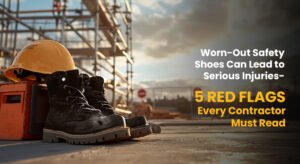
Are your workers wearing worn-out safety shoes?
If yes, you’re not just risking their comfort but their safety.
Safety footwear is the first line of defense in industries where laborers spend hours on their feet, but when that protection wears out, it can silently lead to injuries, fatigue, infections, and costly workplace accidents.
This guide highlights five warning signs that your laborers’ shoes need immediate replacement, and how the right safety shoes can prevent these risks effectively.
Even if shoes “look fine,” they may have already lost their protective features.
1. ⚠️ Worn-Out Tread or Cracked Soles
Why it matters: Laborers walk across oily, wet, or uneven surfaces. If the sole is smooth or cracked, it increases the risk of slips and falls.
Solution: Choose safety shoes with anti-skid soles and strong tread grip for high-risk environments.
2. ⚠️ Flattened or Torn Insoles
Why it matters: Lack of cushioning causes foot fatigue, muscle pain, and poor posture, especially during long shifts.
Solution: The safety shoes must feature memory foam insoles to ensure comfort and reduce fatigue.
3. ⚠️ Loose Fit or Broken Eyelets
Why it matters: A loose shoe increases the risk of ankle sprains or imbalance, particularly during lifting or climbing.
Solution: Reinforced collars, ankle grip, and durable laces would be the defining features for a secure-fit safety shoe.
4. ⚠️ Torn Upper or Exposed Steel Toe
Why it matters: If the upper is damaged or the toe cap is visible, the shoe no longer offers protection from falling tools or heavy objects.
Solution: Use safety shoes made with tough uppers and fully enclosed toe protection.
5. ⚠️ Foul Smell or Constant Dampness
Why it matters: Moisture leads to bacterial and fungal infections, especially in hot climates or long working hours.
Solution: Invest in safety shoes with breathable linings and moisture-wicking fabrics.
Q: How often should laborers change their safety shoes?
A: Ideally, every 6–12 months, or sooner if any of the red flags mentioned above are visible. Routine checks are essential.
Worn-out footwear can lead to avoidable injuries, lost productivity, and financial loss.
✅ Whether it’s anti-skid soles, cushioned insoles, tough toe caps, or breathable lining—every problem has one solution: Hillson Safety Shoes.
They are built for India’s toughest working conditions and trusted by thousands across industries.
🔗 Explore Hillson’s full range of safety footwear here
Copyright 2024 © HILLSON FOOTWEAR PVT. LTD. All Rights Reserved. (Terms of Use)
Developed and Managed by The Lantern Studios